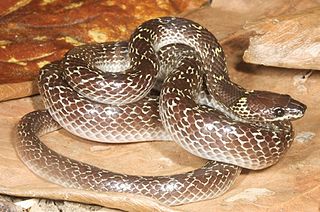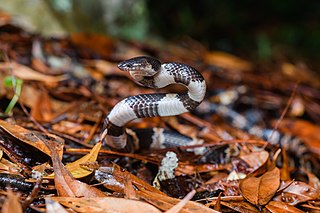Lycodon gammiei, commonly known as Gammie's wolf snake, is a species of nonvenomous colubrid endemic to northern India.

Lycodon capucinus, also known as the Oriental wolf snake, is a species of colubrid snake, which is commonly found in the Indo-Australian Archipelago. Named after their enlarged front teeth, which gives them a muzzled appearance similar to canines, it also makes the snout somewhat more squarish than other snakes.

Lycodon striatus, commonly known as the northern wolf snake or the barred wolf snake, is a species of nonvenomous colubrid snake from southern Asia.

Lycodon fasciatus, commonly known as the banded wolf snake, is a species of colubrid snake.

Lycodon laoensis, commonly known as the Laotian wolf snake, is a species of nonvenomous colubrid snake endemic to Asia.
Lycodon mackinnoni, commonly known as the Himalayan wolf snake, Mackinnon's wolf snake, or the Mussoorie wolf snake, is a species of snake in the family Colubridae. The species is endemic to Western Himalaya.
Lycodon zawi, commonly known as Zaw's wolf snake, is a species of nonvenomous snake in the family Colubridae. The species is native to South Asia and Southeast Asia

Rhinophis fergusonianus, commonly known as the Cardamom Hills earth snake, is a species of uropeltid snake endemic to the Western Ghats, India.

The Cardamom Mountains rain forests is a tropical moist broadleaf forest ecoregion in Southeast Asia, as identified by the WWF. The ecoregion covers the Cardamom Mountains and Elephant Mountains and the adjacent coastal lowlands in eastern Thailand and southwestern Cambodia, as well as the Vietnamese island of Dao Phu Quoc.
Lycodon alcalai, also known commonly as Alcala's wolf snake, is a species of snake in the family Colubridae. The species is endemic to the Philippines.
Lycodon bibonius, also known as Ota's wolf snake, is a species of colubrid snake found on the islands of Camiguin Norte and Babuyan Claro in the Philippines.
Lycodon chrysoprateros, also known as Ross' wolf snake, is a species of colubrid snake found on the island of Dalupiri in the Philippines.
Lycodon solivagus, also known as the common wolf snake, is a species of colubrid snake found on Luzon Island in the Philippines.
Lycodon butleri, also known commonly as Butler's wolf snake, is a species of snake in the family Colubridae. The species is native to southern Thailand and peninsular Malaysia.
Lycodon cavernicolus, also known as Gua Wang Burma wolf snake, is a species of colubrid snake found in peninsular Malaysia. It was first described in 2014.

Oligodon deuvei is a species of snake in the family Colubridae. The species is endemic to Southeast Asia.
Oligodon pseudotaeniatus, commonly known as the false striped kukri snake, is a species of colubrid snake. It is endemic to Thailand and known from the Nakhon Ratchasima Province, Saraburi Province, and Bangkok. The type series was collected by Malcolm Arthur Smith. The specific name pseudotaeniatus refers to its similarity to Oligodon taeniatus, with whom it was confused prior to its species description in 2008.

Lycodon ruhstrati, also known as Ruhstrat's wolf snake, the mountain wolf snake, or the Formosa wolf snake, is a species of non-venomous colubrid snake found in Taiwan, southern and eastern China, and northern Vietnam.
Oligodon annulifer, also known as the ringed kukri snake, is a colubrid snake endemic to the island of Borneo.

Oligodon huahin is a species of kukri snakes in the genus Oligodon. The species was first discovered and described in late 2016, and the article was published July 13, 2017. It is only known from its type locality but its range is likely to be more extensive. O. huahin is thought to be very secretive, similar to other species of the genus Oligodon. This theory is supported by the type specimen, which all were males, suggesting that it was found during the mating season where males are out and actively search for females to reproduce. This may also explain why this species had not yet been discovered









